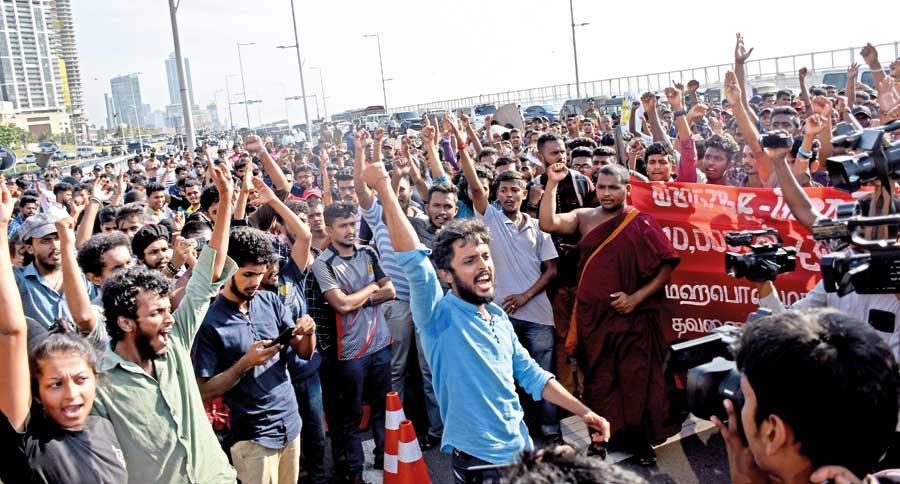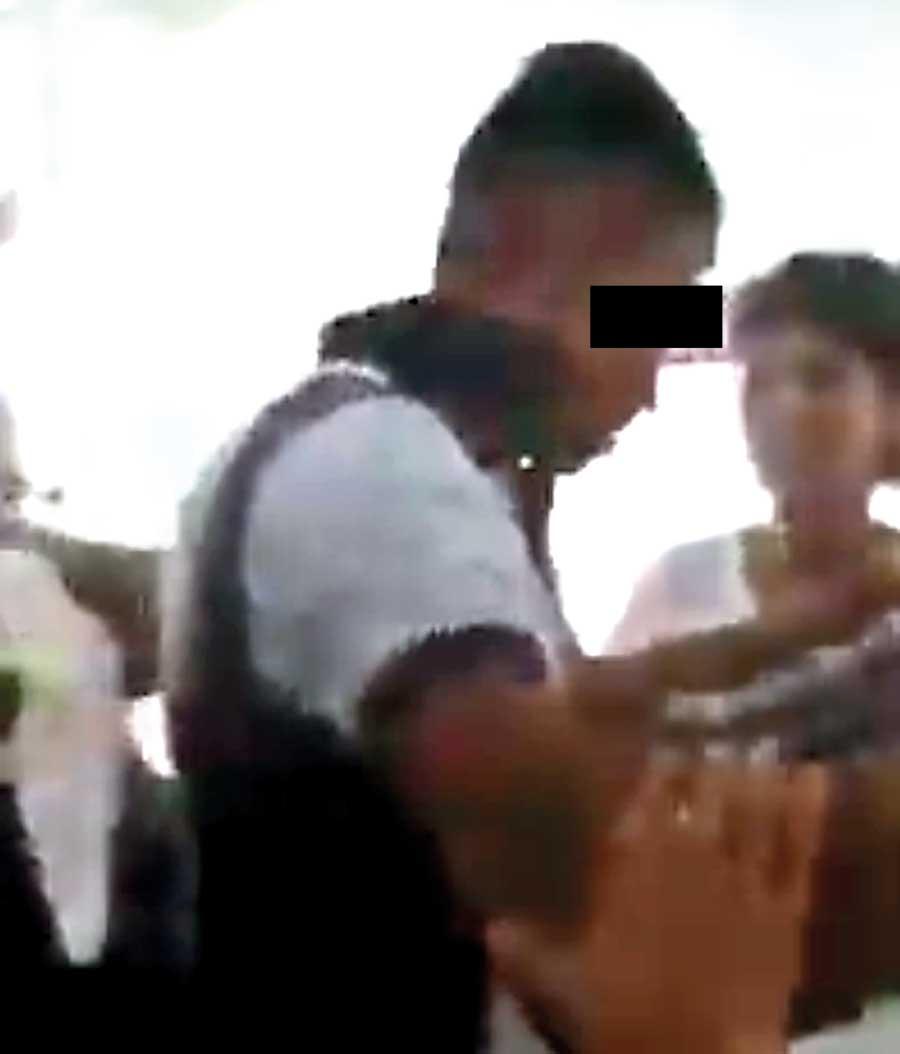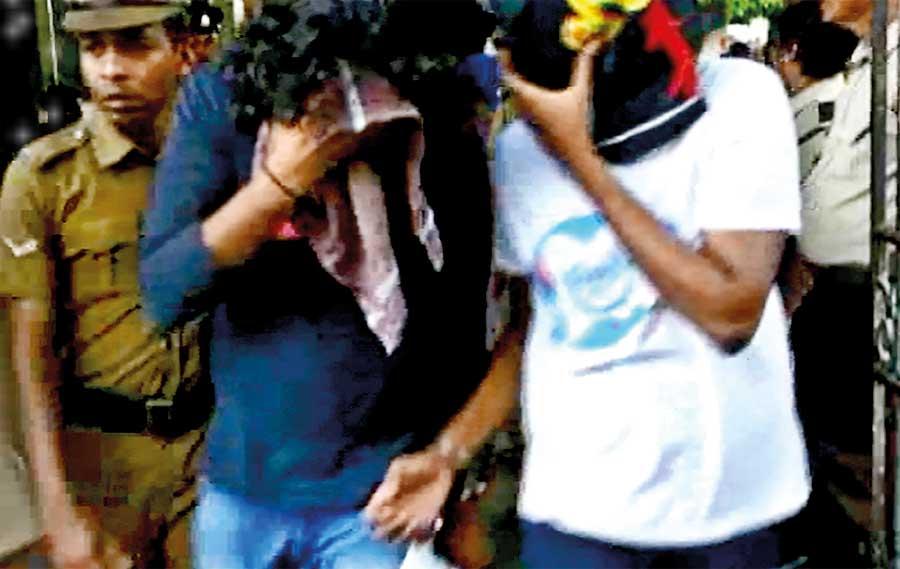16 Jan 2020 - {{hitsCtrl.values.hits}}

Protesting university students presented their demands to the President last week Pic by Kushan Pathiraja
 When news went round that a student at the Colombo University was severely beaten by a group of students, it didn’t take long for people to realise that this too would have been another case of ragging. Justifying suspicions, this case too was a retaliatory action to continuous ragging that existed within the Colombo University. Ragging within the local university system has proven to be a toxic relationship, affecting thousands of university students every year. Although many have high hopes to gain university entrance, it is not really the case today – in fact no more a happy news as many fear having to experience a brutal ragging experience during their fresher period. While several students have taken their lives, several incidents of brutal sexual violence and torture were reported last year too. However, the Gotabaya Rajapaksa manifesto has promised to eliminate ragging in state universities and other higher education institutes from this year. On the other hand the Government is planning to enroll ragging victims back to the universities. In this backdrop the Daily Mirror sheds light on the recent incident while taking a broader look at warning signs of violence among youth.
When news went round that a student at the Colombo University was severely beaten by a group of students, it didn’t take long for people to realise that this too would have been another case of ragging. Justifying suspicions, this case too was a retaliatory action to continuous ragging that existed within the Colombo University. Ragging within the local university system has proven to be a toxic relationship, affecting thousands of university students every year. Although many have high hopes to gain university entrance, it is not really the case today – in fact no more a happy news as many fear having to experience a brutal ragging experience during their fresher period. While several students have taken their lives, several incidents of brutal sexual violence and torture were reported last year too. However, the Gotabaya Rajapaksa manifesto has promised to eliminate ragging in state universities and other higher education institutes from this year. On the other hand the Government is planning to enroll ragging victims back to the universities. In this backdrop the Daily Mirror sheds light on the recent incident while taking a broader look at warning signs of violence among youth.
Brutally beaten
A video that went viral on social media shows how one student is brutally being beaten by a group of students. The video shows a heated exchange among a group of students that ends with one student severely whacking another student with a chair. It further shows the group dispersing after one student starts bleeding. However, a group of second year students have severely ragged first year students within the university premises and at a students’ hostel situated in Borella over the past few days. The 12 students who were arrested were produced before the Colombo Chief Magistrate and were bailed out on a surety of Rs. 100,000. The injured student was receiving treatment at the Colombo National Hospital and has been discharged. However, viewers suspected whether the students were intoxicated, but the Cinnamon Gardens Police confirmed that the students were not intoxicated during the incident. The students were arrested on charges of causing injuries, intimidation, assaulting etc.
Busting social ideologies
The Frontline Socialist Party (FSP) has been backing university student unions to find ground as powerful bodies within the university system. Although they may perceive it as a Leftist approach, the intensity of ragging has reached a point where the Government is now planning to privatise the education system as means of disbanding student unions. “As a party we will always advocate against ragging, but this incident doesn’t seem to have a link to ragging,” claimed Duminda Nagamuwa, FSP’s politburo member and propaganda secretary. “The Inter University Student Federation (IUSF) has taken a revolutionary stance to bust certain political ideologies and therefore it is being portrayed as an unethical body. Ragging is one example of a primitive culture that we live in. However, the Government has said that it will move into the privatisation of the education system as means of attacking the IUSF. But we are well aware of how they get hold of Chief justices, senior lawyers and have created a mess among the Executive and the Legislature. This is a power struggle,” said Nagamuwa.
As a result of ragging, many lives were lost while some never made it to their dream professions. However, Nagamuwa claims that when students protest it doesn’t have an impact on the economy, but only on certain ideologies among people,” he continued. “They are trying to create an impact on the way people think. Ragging needs to be eliminated through a collective effort. Authorities and lawmakers need to understand the root causes and address them,” he also said.

Assaulted student
Sub-cultures and democratic principles
Yet it has continuously been proven that University staff and authorities have turned a blind eye to these incidents as they too have been part of or victims of the ragging culture. Dr. Athulasiri Samarakoon, Senior Lecturer at the Political and International Relations Unit at the Open University of Colombo however condemned ragging and believes that violence in any form is unacceptable. “There exists a hierarchical attitude among students and they don’t respect the element of sub-culture. But sub-cultures shouldn’t be above democratic principles. Everything needs to be done in a way to uphold democracy. Therefore student organisations, particularly the IUSF has a bigger role to play in bringing about democratic order within the university system. This is organised violence because nobody reveals the truth behind these incidents which means everybody supports it. The university system has faced a tragic situation where nobody talks about others’ rights. We hardly practise these. In fact human rights are not respected at all within state institutions,” said Dr.Samarakoon.
Dr. Samarakoon further said that it is ugly to see students breaking into clashes in an institution with intellectuals and academics. “As an academic I strongly condemn any form of violence and we should in fact learn to tolerate differences. Sadly, the future of the university system looks very bleak,” he said.
Ragging is one example of a primitive culture that we live in. However, the Government has said that it will move into the privatisation of the education system as means of attacking the IUSF - Duminda Nagamuwa
Not a sign of an educated society
When a student at the Ruhuna University exposed the physical abuse he experienced as a result of ragging, 19 students were taken into custody. In another incident, a group of students at the Peradeniya University had rented a house which was operated as a torture house to rag freshers. The intensity of reported and unreported ragging incidents seems to be taking horrific turns. Speaking about the recent incident, Colombo University Vice Chancellor Prof. Chandrika Wijerathne said that the Police and the authorities are taking actions within the legal framework. “An inquiry is being conducted to find the root causes of the incident and we will take a collective effort to bring the matter under control. This is not an incident related to ragging, but such incidents cannot happen within an educated society. We are continuing to probe into the matter,” said Prof. Wijerathne.
Making use of the Ragging Act
The Prohibition of Ragging and Other Forms of Violence in Educational Institutions Act No. 20 of 1998 elaborates on punishments for ragging, criminal intimidation, hostage taking, wrongful restraint, unlawful confinement and forcible occupation and damage to property of an educational institution. However, those who advocate against ragging suggest that these students should never get job placements in any industry. “Ragging should be considered as a violation of the public law of the country and we are looking at considering the Ragging Act from now onwards,” opined University Grants Commission Chairman Prof. Sampath Amaratunge. “We have enough rules and regulations when it comes to this issue, but we are reluctant to use the Ragging Act. However we have also realised that we don’t get many complaints related to ragging incidents. But the UGC will collect them and work with the Attorney General’s Department and take these matters to courts. We will have a zero tolerance policy on ragging,” said Prof. Amaratunge.
He further said that lecturers should take some time off to give insights to students on these matters. “The university system includes proctors, marshals, security and other staff members and public awareness is also important. When it comes to public universities, more than 95 percent are innocent and are not involved in these incidents. But these incidents not only damage the image of public universities, but also the image of that 95 percent of students as well. Therefore they have issues when looking for jobs as well. Therefore I suggest that students should receive a letter from the Vice Chancellor on the day of their graduation, stating whether they are suitable for any industry or not,” he added.
Zero tolerance on ragging from this year
Although successive governments have made minimal attempts to put an end to ragging, such attempts have miserably failed. However, the newly appointed Minister of Information and Communication Technology, Higher Education, Technology and Innovation Bandula Gunawardena said that ragging will not be tolerated in university campuses from this year. Addressing a media briefing last week the Minister pointed out that close to 2000 students have given up on university education as a result of ragging. According to statistics provided by the UGC, over 1900 students have dropped out of the university system due to ragging.
There exists a hierarchical attitude among students and they don’t respect the element of sub-culture. But sub-cultures shouldn’t be above democratic principles Dr. Athulasiri Samarakoon
Warning signs of youth aggression
According to the American Psychological Association (APA) aggressions is described as behaviour aimed at harming others physically or psychologically. It could be distinguished from anger in that anger is oriented at overcoming the target, but not necessarily through harm or destruction. Affective aggression includes an emotional response that tends to be targeted towards the perceived source of distress, but maybe placed on to other people or objects if the disturbing agent cannot be attacked.

Undergraduates arrested regarding an alleged ragging incident, at the Colombo University, seem to have lost some of the courage with which they inflicted pain on first years as they cover their faces after being arrested
Reasons for youth aggression
Expression : Some people use violence to release feelings such as anger or frustration. They think there are no answers to their problems and turn to violence to express their out-of-control emotions.
Manipulation : Violence is used as a way to control others or get what they want.
Retaliation :Violence is used as a way to retaliate against those who have hurt them or someone they care about.
Violence as a learned behaviour : Psychologists claim that like all behaviours, violence and aggression could be changed. Yet there is no single cause of violence or one simple solution. The best you could do is to learn the warning signs of violence and help when you see them in your friends or family.
Recognising warning signs of violence
Some signs of potential for violence may be historical or static (unchangeable) factors like:
When it comes to public universities, more than 95% are innocent and aren’t involved in these incidents. These incidents also damage the image of public universities and the image of those 95% of students - Prof. Sampath Amaratunge
Other signs of potential violence may be present over time and may escalate or contribute to the risk of violence given a certain event or activity. These might include:
Some signs of potential violence may be new or active signs. They might look like:
28 Nov 2024 2 hours ago
28 Nov 2024 2 hours ago
28 Nov 2024 3 hours ago
28 Nov 2024 5 hours ago
28 Nov 2024 6 hours ago